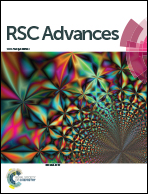Ratiometric fluorescent pH-sensitive polymers for high-throughput monitoring of extracellular pH†
Abstract
Extracellular pH has a strong effect on cell metabolism and growth. Precisely detecting extracellular pH with high throughput is critical for cell metabolism research and fermentation applications. In this research, a series of ratiometric fluorescent pH sensitive polymers are developed and the ps-pH-neutral is characterized as the best one for exclusive detection of extracellular pH. Poly(N-(2-hydroxypropyl)methacrylamide) (PHPMA) is used as the host polymer to increase the water solubility of the pH sensitive polymer without introducing cell toxicity. The fluorescent emission spectra from the polymeric sensor under excitation at the isosbestic point 455 nm possess two fluorescence peaks at 475 nm and 505 nm, which have different responding trends to pH. This enables the polymer to detect pH using fluorescent maxima at 475 nm and 505 nm (I475 nm/I505 nm) ratiometrically. The cell impermeability ensures the sensor can solely detect the environmental pH. The sensor is tested to detect the extracellular pH of bacteria or eukaryotic cells in high throughput assays using a microplate reader. Results showed that the pH sensor can be used for high throughput detection of extracellular pH with high repeatability and low photobleaching effect.


 Please wait while we load your content...
Please wait while we load your content...